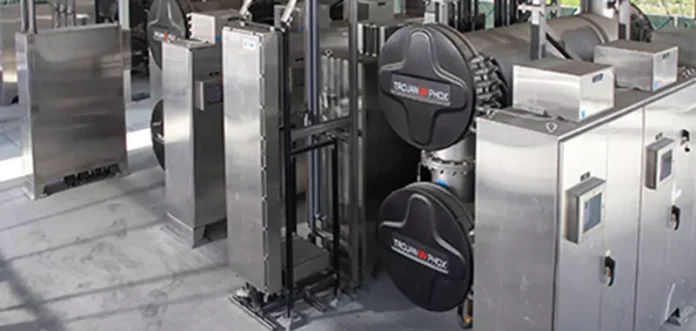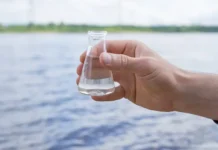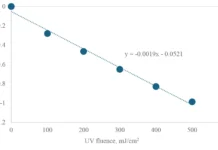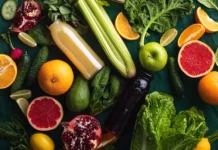By IUVA One Water
With increasing stress on water systems, obtaining and maintaining water security, sustainability and resilience is becoming increasingly necessary, and UV water treatment can play an important role in addressing these concerns. Commonly referred to as One Water, this approach for planning and integrating water reuse better serves communities and ecosystems by improving the way wastewater is handled. Understanding the extent of UV applications in drinking water, wastewater, stormwater and industrial water treatment allows for improved reuse of this finite resource.
Contaminants of emerging concern
The combination of UV-hydrogen peroxide and, in some specific applications, UV-chlorine as advanced oxidation processes (AOP) is serving the water reuse industry well around the globe, from projects in Europe to Australia to the US and elsewhere. It also is proven that AOPs followed by a biologically active filtration step – often involving GAC filters – provide an excellent synergy to reduce contaminants of emerging concern (CECs) and deliver a biologically stable, low overall toxicity-tested drinking water.
Growing bodies of research aim to explore UV applications, especially for CECs, such as pharmaceuticals, personal care products and per- and polyfluoroalkyl substances (PFAS). With limited effectiveness of conventional treatment technology, these contaminants require innovative solutions and the application of UV light in ways it previously hasn’t been utilized. Advanced oxidation and reduction processes continue to show promise in addressing these contaminants.
In the realm of advanced oxidation, the development of a standard protocol for the determination of the “OH scavenging term” of a water sample is being led by an IUVA task force. This team of about 20 industry experts and academics is determining a consensus around this key parameter and planning an experimental validation phase with the goal of producing a protocol to better evaluate water matrices from a variety of sources in relation to treatment by advanced oxidation.
Another, much less commonly explored application, has been found to degrade perfluorooctanoic acid (PFOA), one of the most frequently detected PFAS.
Boron nitride can be catalyzed by UV doses at 254 nm. PFOA has characteristic carbon-fluorine bonds that are resistant to most treatment options. Photogenerated forms of oxygen have been shown in the work by Duan et al. to cause reactions leading to stepwise decarboxylation and defluorination of PFOA. These unexpected results give hope to further UV applications for water treatment that are yet to be discovered.
Sustainable water technologies: UV LED
With the need for further research and development, cutting edge opportunities exist at universities and organizations such as Wetsus in the Netherlands, a European center of excellence for sustainable water technology.
Valuing innovation and partnership, this organization offers multidisciplinary, collaborative Ph.D. programs in the areas of new water sources, wastewater treatment and reuse, detection of pathogens and micropollutants, and more. It is mentioned here due to its recent broad announcement making Ph.D. opportunities available for its ongoing sustainable water projects involving UV LED applications.
AquiSense Technologies and BOSAQ, a multi-faceted water technology company based in Ghent, Belgium, are improving access to clean water with the SolarAQ II, a UV LED disinfection system equipped with robust membrane technology. Designed with sustainability in mind, this system has a compact footprint, parallel UV systems and the potential to be driven from a renewable/battery voltage source. It is used in rural areas, decentralized water supplies, defense and disaster relief, as well as other off-grid industries providing self-sufficiency for users.
Continued planning and implementation of UV systems in drinking water and wastewater has occurred from coast to coast across the US, ranging in design flow and reactor size. Calgon Carbon has several notable projects in the works, including two 30 million-gallons-per-day (MGD) drinking water facilities in North Dakota and New York, with another 25 MGD facility in West Virginia. Among other smaller drinking water applications, one 5.7 MGD wastewater project is in process.
The COVID-19 pandemic caused many changes to industries across the globe, including the UV industry. A new interest in fighting viral pathogens has led to a noteworthy surge in UV products. With the new focus on UV in the marketplace, production of UV products increased within UV industries, and a major shift to UV lighting was observed in the general lighting industry. As a result of this uptick in UV use, a shortage of bulbs and cost increases have been reported for more conventional water applications. The fate of the UV bulb shortage will either cease due to declining interest in UV as the pandemic fades into the past or increase UV bulb manufacturing to meet the demand.
Thanks to industry connections for their contributions to the writing of this column, especially Laith Furatian of Stantec, Oliver Lawal and Mitch Hansen of AquiSense Technologies, Keith Bircher of Calgon Carbon, and Harold Wright and Nicola Fontaine of Carollo Engineers.
The “One Water” column seeks to highlight the application of UV technologies to the traditional areas of drinking water, wastewater, water reuse, agricultural and industrial process water, and stormwater. The goal of the column is to further evolving understanding and focus, driven by YP members, on sustainable water – reminding stakeholders that there is one water cycle on earth.
Contact: Cassidy Yates, cry1004@wildcats.unh.edu; Nicola Elardo, nicola.elardo@unh.edu; Castine Bernardy, cab2020@wildcats.unh.edu
References
“Efficient Photocatalytic PFOA Degradation over Boron Nitride.” Environmental Science & Technology Letters 2020 7 (8). www.pubs-acs-org.
Water and Waste Digest. UV Disinfection Market Update. Oliver Lawal. February 23, 2021. www.wwdmag.com.






